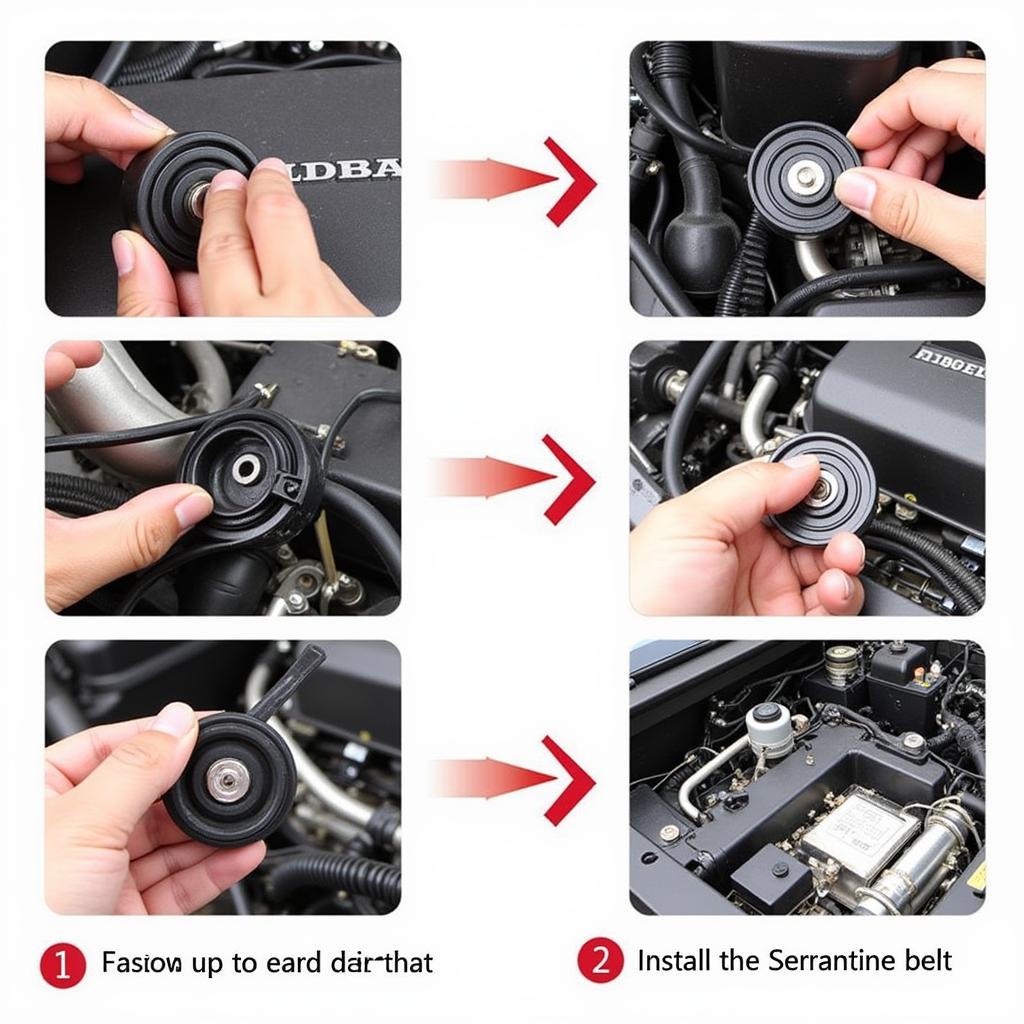A failing car tensioner can lead to a host of problems, from annoying squeals to catastrophic engine damage. Understanding the Car Tensioner Problem is crucial for maintaining your vehicle’s performance and longevity. This guide will delve into the intricacies of car tensioner issues, providing you with the knowledge you need to diagnose, troubleshoot, and resolve them effectively.
Having problems with your Ava Devine’s car? Check out this resource: ava devine car problems.
What is a Car Tensioner and Why is it Important?
The serpentine belt, a crucial component of your car’s engine, powers essential accessories like the alternator, power steering pump, and air conditioning compressor. The car tensioner maintains the correct tension on this belt, ensuring it grips the pulleys properly and efficiently transfers power. A malfunctioning tensioner can cause the belt to slip, stretch, or even break, leading to a cascade of issues.
Common Symptoms of a Car Tensioner Problem
Identifying a failing tensioner early can save you time and money. Here are some telltale signs:
- Squealing noises: A high-pitched squeal, especially upon starting the engine or when accelerating, is a common indicator of a slipping belt due to a loose or faulty tensioner.
- Belt slippage: Visible belt slippage or a loose belt can signify a weakened tensioner spring or a worn-out pulley.
- Vibration: Excessive vibration from the tensioner assembly itself can indicate worn bearings or damage to the tensioner arm.
- Overheating: A broken belt, caused by a failed tensioner, can disable the water pump, leading to engine overheating.
- Battery light illumination: If the alternator belt slips due to a bad tensioner, the battery won’t charge properly, causing the battery light to illuminate.
 Car Tensioner Squealing Belt Problem
Car Tensioner Squealing Belt Problem
Diagnosing a Car Tensioner Problem
Proper diagnosis is crucial for effective repair. Here’s a step-by-step guide:
- Visual inspection: Check the belt for signs of wear, cracks, or fraying. Also, examine the tensioner pulley for wobble or damage.
- Tensioner movement: Gently push the tensioner with a wrench to assess its movement. It should move smoothly and offer adequate resistance. A stiff or loose tensioner indicates a problem.
- Listening for noises: Start the engine and listen for squealing or grinding noises. Pay attention to changes in noise when accelerating or using accessories.
- Pulley check: Rotate each pulley by hand to check for smooth rotation and any signs of bearing noise or resistance.
If you are facing belt issues with your Club Car, this might be helpful: club car belt problems.
Replacing a Car Tensioner
While some tensioner issues can be resolved by simple adjustments, replacement is often the best solution. Here’s a simplified guide, but remember, procedures may vary depending on the car model. Always consult your vehicle’s repair manual.
- Gather tools and parts: Obtain the correct replacement tensioner and necessary tools, including wrenches, sockets, and a serpentine belt tool.
- Relieve tension: Use the serpentine belt tool to relieve tension on the belt and remove it from the pulleys.
- Remove the old tensioner: Unbolt the old tensioner from the engine block.
- Install the new tensioner: Bolt the new tensioner in place, ensuring proper alignment.
- Route the new belt: Follow the correct routing diagram (usually found under the hood) to install the new belt.
- Apply tension: Use the serpentine belt tool to apply the correct tension to the new belt.
- Double-check: Inspect the belt and tensioner for proper installation and alignment. Start the engine and check for any unusual noises.
 Replacing Car Tensioner Step-by-Step
Replacing Car Tensioner Step-by-Step
“A properly functioning tensioner is vital for the health of your engine. Don’t ignore those squeals and vibrations – they might be telling you something important!” – John Davis, Automotive Engineer
Having trouble with your Hyundai Genesis? You might find this relevant: hyundai genesis car problems.
Preventing Car Tensioner Problems
Regular maintenance is key to preventing car tensioner problems. Regularly inspect the serpentine belt for wear and tear and replace it according to the manufacturer’s recommendations. Also, have a mechanic check the tensioner during routine inspections.
Car Tensioner Problem: FAQs
Q: How often should I replace my car tensioner?
A: While there’s no set interval, most mechanics recommend replacing the tensioner along with the serpentine belt.
Q: Can I drive with a bad car tensioner?
A: Driving with a bad tensioner can lead to further damage and potentially leave you stranded. It’s best to address the issue promptly.
Q: How much does it cost to replace a car tensioner?
A: The cost varies depending on the make and model of your vehicle but generally ranges between $100 and $300.
Q: What causes a car tensioner to fail?
A: Normal wear and tear, extreme temperatures, and exposure to contaminants can cause a tensioner to fail.
Q: Can I replace a car tensioner myself?
A: Yes, with the right tools and knowledge, it’s a manageable DIY project. However, if you’re unsure, consult a professional mechanic.
Struggling with airbag issues in your 1996 Lincoln Town Car? This may help: 1996 lincoln town car airbag problems.
Conclusion
A car tensioner problem, while seemingly minor, can have significant consequences for your vehicle. By understanding the symptoms, diagnosis, and repair procedures outlined in this guide, you can keep your car running smoothly and avoid costly repairs. Remember, regular maintenance and prompt attention to any unusual noises are key to preventing car tensioner problems and ensuring the longevity of your engine. If you need assistance, feel free to connect with us at AutoTipPro. Call us at +1 (641) 206-8880 or visit our office at 500 N St Mary’s St, San Antonio, TX 78205, United States.
Are you having issues with your Mazda CX-9? Check this out: mazda cx 9 car problems.







Leave a Reply